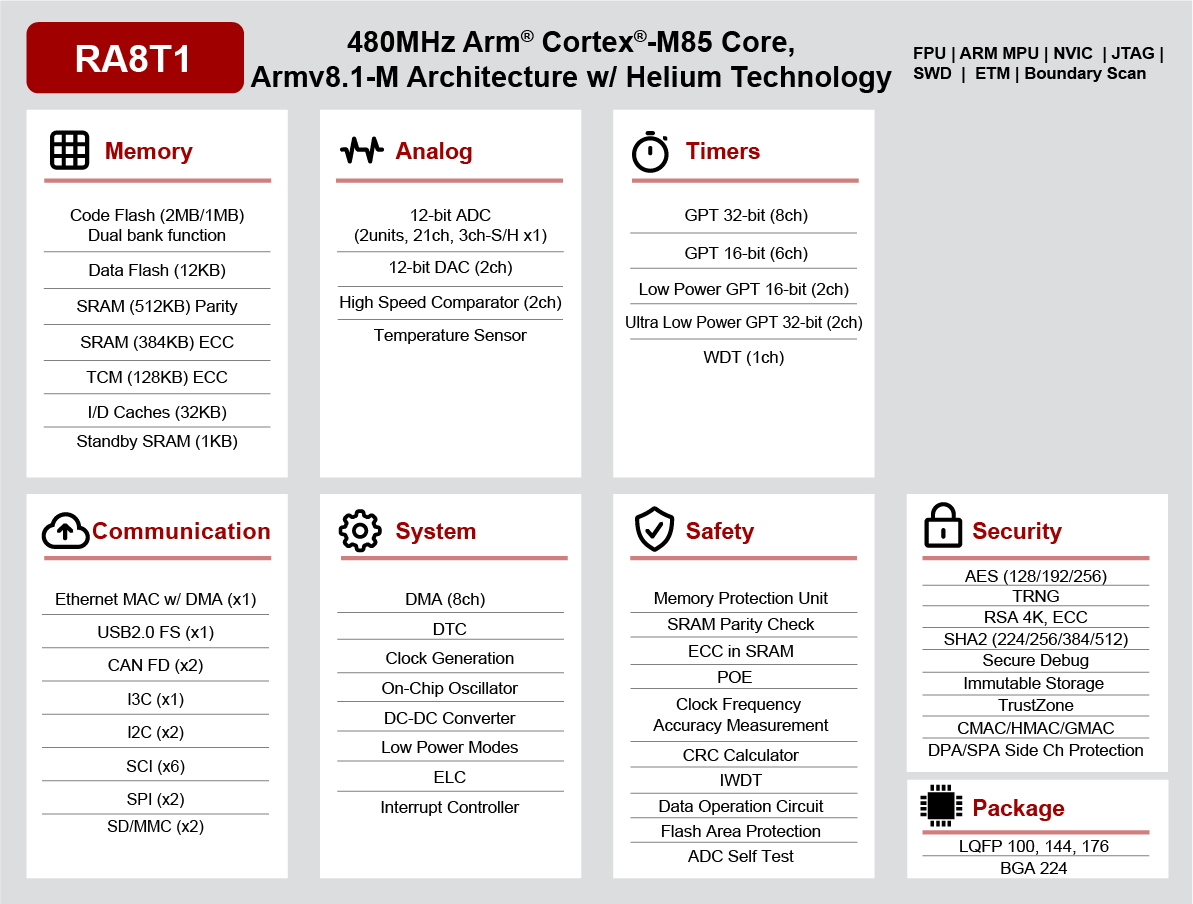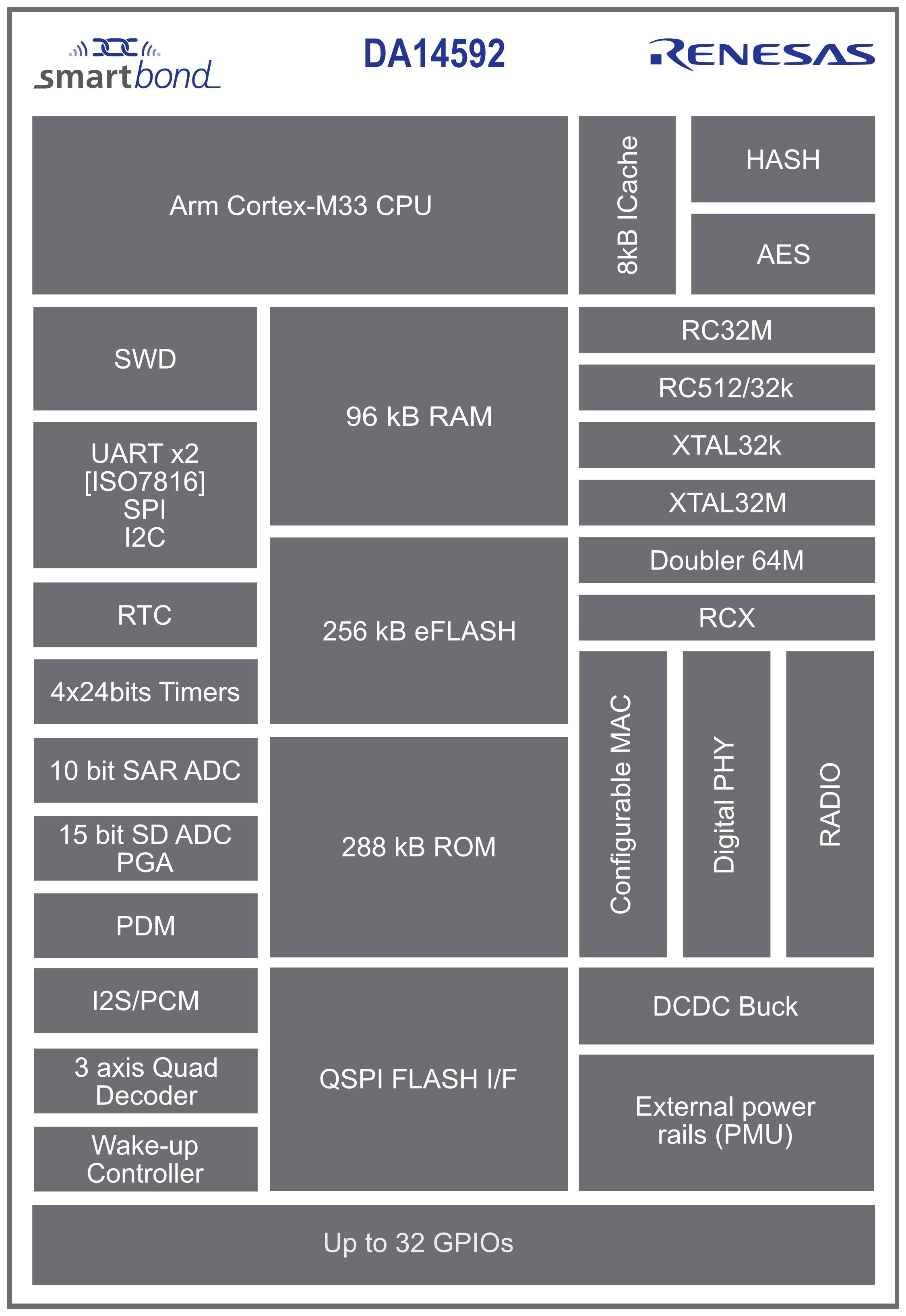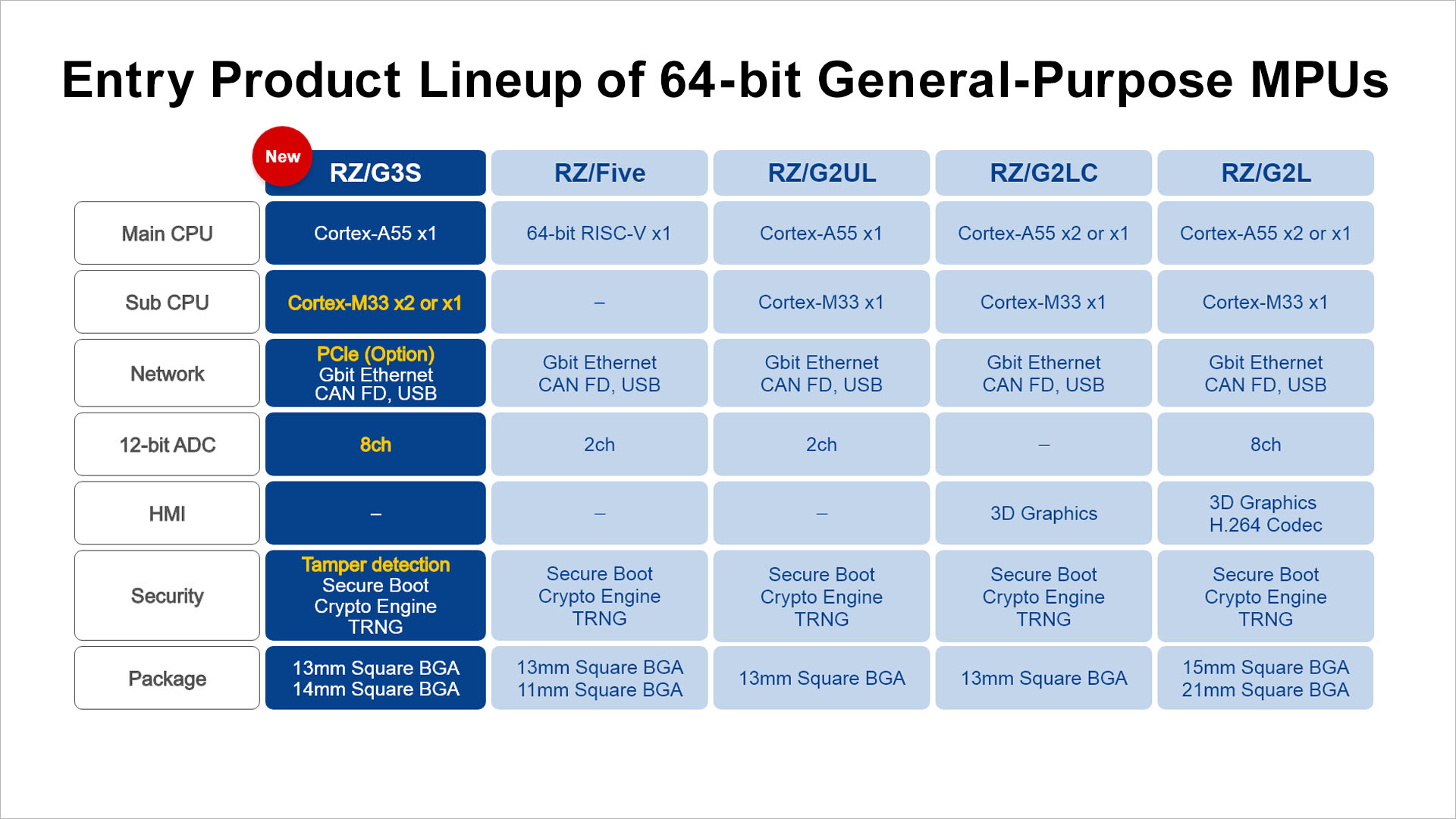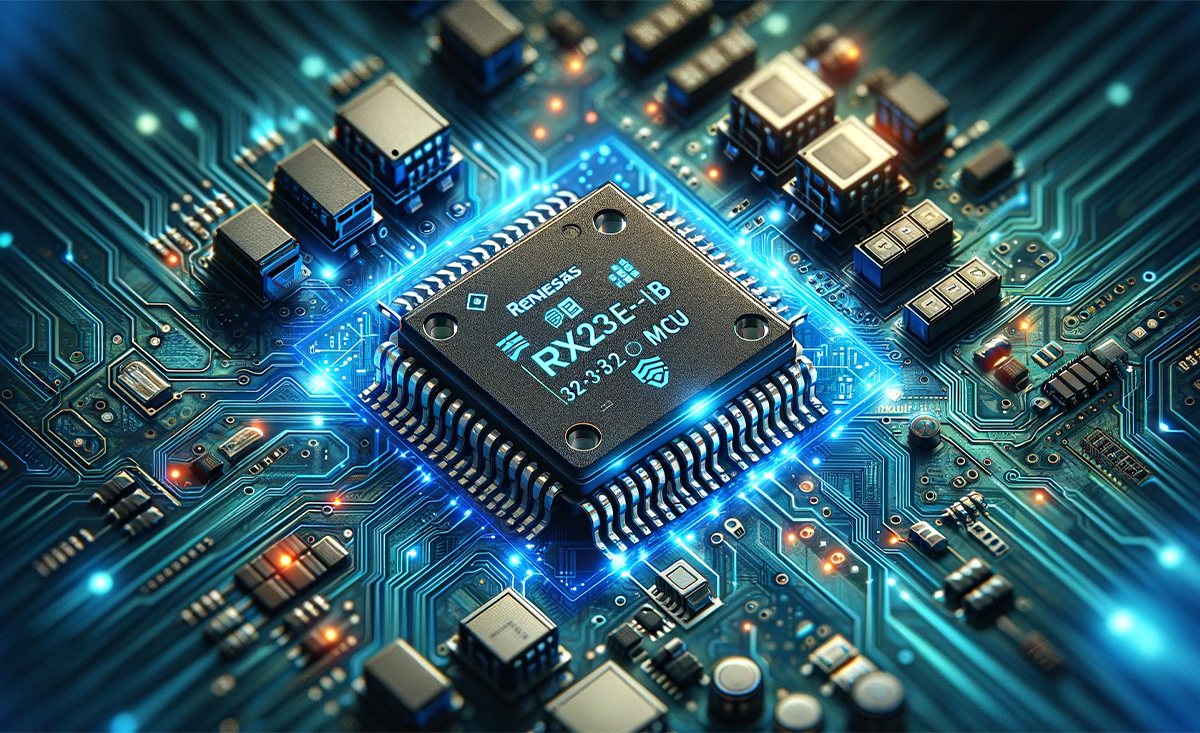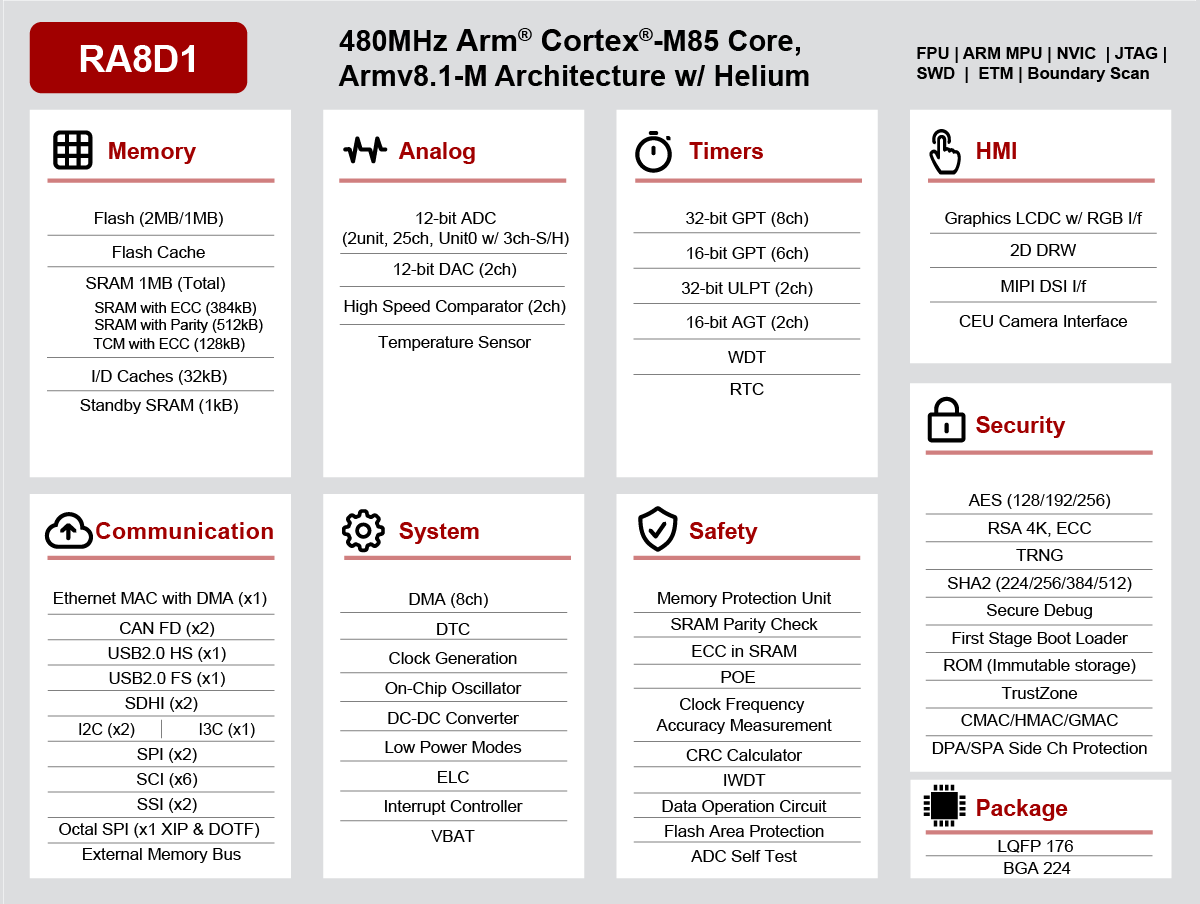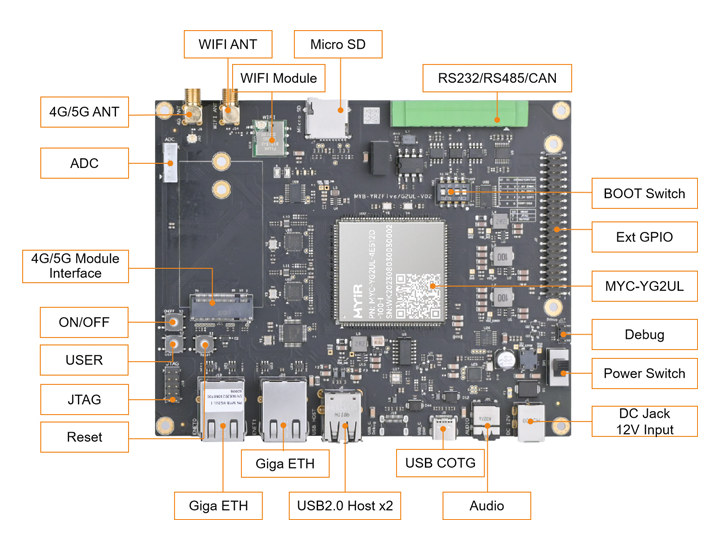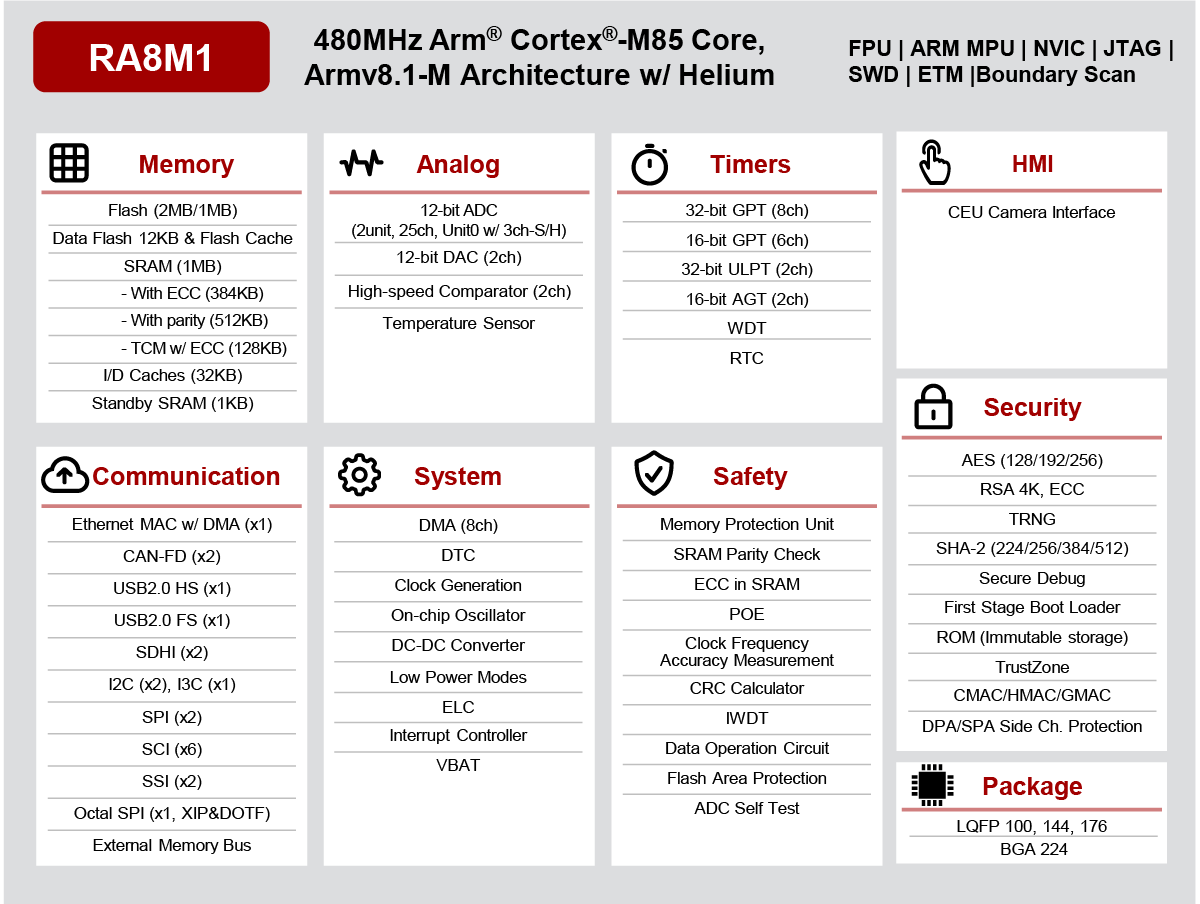It took a while before Renesas released its first Arm Cortex-M85 microcontroller (RA8M1) in October 2023, but the company has now launched the RA8T1 Cortex-M85 MCU for motor control just a few weeks after announcing the RA8D1 for HMI applications. The RA8T1 group is the third Cortex-M85 microcontroller family from Renesas with a feature set optimized for motor control and leveraging machine learning through Arm Helium technology and a DSP for predictive maintenance requirements for motors. Renesas RA8T1 key features and specifications: MCU core – Arm Cortex-M85 clocked at 480 MHz with Helium MVE (M-Profile Vector Extension) with 32KB I/D caches, 12KB data flash Memory & Storage 1MB SRAM including 128KB TCM 1MB to 2MB Flash memory 2x SD/MMC host interfaces (SDHI) Communication interfaces Ethernet MAC with DMA USB – 1x USB 2.0 Full Speed interface 2x CAN-FD Up to 6x SCI (UART, Simple SPI, Simple I2C) 2x SPI up […]
Renesas releases the DA14592, a new dual-core Cortex-M33/M0+ BLE chip with integrated flash
The DA14592 System-on-Chip (Soc) is Renesas’ “lowest power consumption and smallest, multi-core Bluetooth LE device.” According to the company, this chip’s design was achieved by making careful tradeoffs between on-chip memory and die size. The chip offers an ultra-low power mode that uses only 2.3mA when transmitting radio signals at 0dBm and consumes 1.2mA to receive radio signals. It also supports a hibernation mode that uses about 90nA and can extend the operating life of battery-powered products. The active mode is best for processing-intensive products and uses 34µA for every MHz of CPU clock. Projected key applications for the DA14592 chip include crowd-sourced location (CSL) tracking as used in Apple’s Airtags, remote control units, human interface devices, asset tracking, IoT end nodes, data logging, connected health, and activity tracking. Renesas DA14592 specifications: CPU cores: Cortex-M33F running at up to 64MHz as application core Cortex-M0+ at 64MHz as configurable MAC Memory: […]
Renesas RZ/G3S is a 64-bit Arm Cortex-A55/M33 microprocessor with low power consumption and enhanced peripherals
Renesas RZ/G3S 64-bit Arm Cortex-A55 microprocessor (MPU) designed for IoT edge and gateway devices consumes as little as 10µW in standby mode thanks to its Cortex-M33 core(s) and features a PCIe interface for high-speed data transfers with 5G wireless modules. A single-core ARM Cortex-A55 CPU powers the RZ/G3s and can distribute workloads to two sub-CPUs, boosting efficiency in task handling and resulting in fewer components and a smaller system size. The Cortex-A55 core operates at 1.1GHz and is designed to improve power efficiency and performance over its predecessor, the Cortex-A53. The RZ/G3S isn’t Renasas’ first Cortex-A55 product as they have previously released the RZ/A3UL and the RZ/G2L, both powered by the same Cortex-A55 CPU. Additionally, Renesas launched the 64-bit RISC-V RZ/Five processor late last year. The RZ/G3S boasts high-speed interfaces such as PCIe and GbE, a better standby mode, and improved security features which make it suitable for IoT applications […]
Renesas’ RX23E-B MCU offers a low-drift 24-bit A/D converter with a 125 kSPS sampling rate
Renesas’ new RX23E-B MCU offers a low-drift 24-bit delta-sigma A/D converter with up to 125 kS/S Sampling Rate – That is eight times faster than its predecessor. This controller is clocked at 32-MHz and offers up to 256 KB Flash memory rail-to-rail programmable gain instrumentation amplifiers, ±10 V input pins, a low-drift voltage reference, and on-chip excitation current sources. This year Renesas introduced a range of new products including, the RZ/T2L Arm Cortex-R52 with an EtherCAT controller, and the RA4E2 and RA6E2 Arm Cortex-M33 MCUs for wearables and appliances. Renecus also released its first 32-bit RISC-V CPU this year, you can check those out if interested. Features of Renesas’ RX23E-B MCU: CPU: 32 MHz 32-bit RXv2 core Includes FPU/DSP instructions Memory: 256 KB code Flash 8 KB data Flash 32 KB SRAM 24-bit Delta-Sigma ADC with PGA: High data rate: max 125 kSPS Ultra-low noise: 190 nVRMS at 977 SPS/gain=64 […]
Renesas RA8D1 Arm Cortex-M85 SoC features LCD display interfaces, 2D graphics accelerator
Renesas RA8D1 is a new Arm Cortex-M85 microcontroller with graphics capabilities such as a 2D graphics accelerator and MIPI DSI and parallel RGB interfaces to connect an LCD that will make the chip suitable for HMI applications. Renesas introduced the world’s first Arm Cortex-M85 microcontroller with the RA8M1 just a few weeks ago, but the MCU has limited multimedia capabilities with just a 16-bit Capture Engine Unit (CEU) interface to connect a camera. The second member of the Renesas RA8 family fills this void with the RA8D1 microcontroller adding an LCD controller and a 2D graphics drawing engine on top of the CEU camera interface. Renesas RA8D1 specifications: MCU core – Arm Cortex-M85 clocked at 480 MHz with Helium MVE (M-Profile Vector Extension) with 32KB I/D caches, 12KB data flash Memory & Storage 1MB SRAM with TCM (128KB) 1MB to 2MB Flash memory 32-bit external SDRAM interface Display interfaces and […]
Renesas’ first 32-bit RISC-V CPU core delivers up to 3.27 CoreMark/MHz
Renesas has recently announced its first homegrown 32-bit RISC-V CPU core based on the open-standard instruction set architecture (ISA). This CPU core is compatible with Renesas’ e2 studio IDE and supports other third-party IDEs for RISC-V MCUs. According to Renesas, the CPU achieved a remarkable 3.27 CoreMark/MHz performance outperforming similar RISC-V architectures in this category. RISC-V, an open ISA, is rapidly gaining popularity in the semiconductor industry. Many MCU providers have formed joint investment alliances to expedite their RISC-V product development. Previously, Renesas released two CPUs developed by Andes Technology Corp: the R9A02G020, an ASSP EASY MCU for Motor Control, and the R9A06G150, an ASSP EASY MCU for Voice HMI, both based on RISC-V. Additionally, they have introduced the RZ/Five, a Linux-capable 64-bit RISC-V microprocessor family, and RH850/U2B, an automotive System on Chip (SoC). However, with the release of their new CPU, Renesas independently enters the RISC-V market, highlighting their […]
Renesas RZ/G2UL Arm Cortex-A55/Cortex-M33 industrial system-on-module sells for as low as $17 in volume
MYiR Tech MYC-YG2UL is a tiny (39x37mm) system-on-module based on the Renesas RZ/G2UL SoC with a 1GHz Arm Cortex-A55 application core and 200MHz real-time Cortex-M33 cores designed for industrial HMIs and gateways, and the company has also launched the MYD-YG2UL development board with the module and interfaces such dual gigabit Ethernet, RS485, RS232, CAN Bus, and more. MYC-YG2UL Renesas RZ/G2UL CPU module Specifications: SoC – Renesas RZ/G2UL (Type-I) CPU – Arm Cortex-A55 processor at up to 1 GHz MCU – Arm Cortex-M33 clocked at up to 200 MHz GPU – 2D graphics (Image Scaling Unit) System Memory – 512MB DDR3L Storage – 4GB eMMC flash, 4KB EEPROM 1.0mm pitch 140-pin castellated holes and 50-pin LGA Display – RGB LCD interface Camera – MIPI CSI interface Networking – 2x RGMII (gigabit Ethernet) USB – 2x USB 2.0 Analog – 2x ADC Other I/Os – 5x SCIF, 2x SCI, 2x CAN FD, 4x […]
Renesas RA8M1 is the world’s first Arm Cortex-M85 microcontroller
Renesas RA8M1 is an up to 480 MHz Arm Cortex-M85 microcontroller with Arm Helium technology to improve DSP and machine learning performance on Cortex-M microcontrollers, and delivering up to 6.39 CoreMark/MHz performance using EEMBC’s CoreMark, or over 3,000 CoreMark at 480 MHz. The Arm Cortex-M85 core was first unveiled in April 2022 as a faster Cortex-M7 alternative and new Arm Helium technology that delivers machine learning performance similar to Cortex-M55 application processor. We had some teases about the upcoming Renesas Cortex-M85 in the last year, but the world’s first Cortex-M85 microcontroller is finally here. Renesas RA8M1 key features and specifications: MCU core – Arm Cortex-M85 clocked at 240 to 480 MHz with Helium MVE (M-Profile Vector Extension) with 32KB I/D Caches and 12KB Data Flash Memory & Storage 1MB SRAM with TCM 1MB to 2MB Flash memory External memory interfaces (CS/SDRAM) Camera – 16-bit Capture Engine Unit (CEU) interface Communication […]


